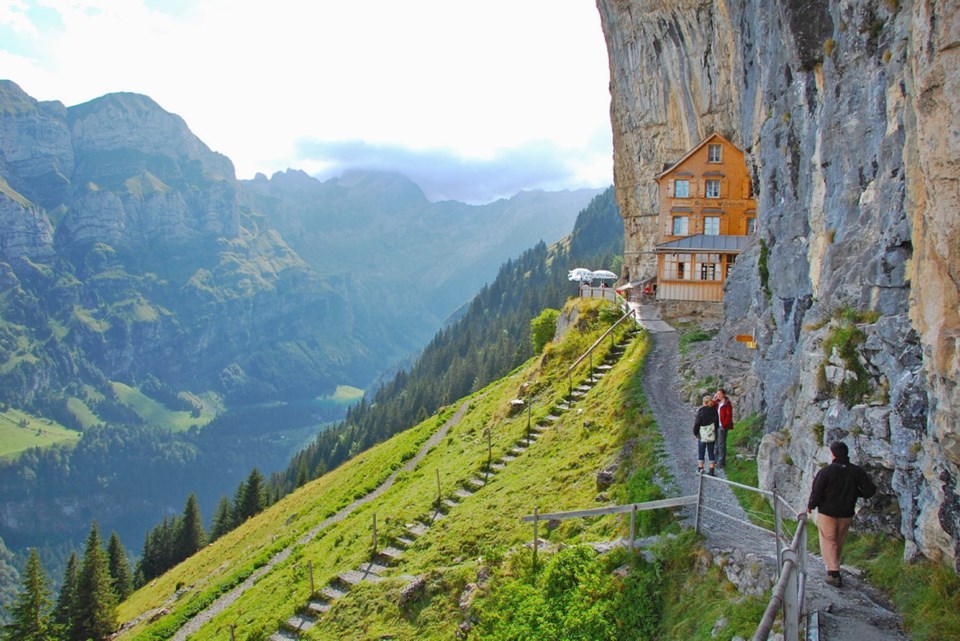Switzerland is excellent at promoting itself, and its most famous experiences ŌĆö the Matterhorn, fondue, chocolate ŌĆö are worth the hype. But if youŌĆÖre planning a Swiss adventure, consider these lesser-known Swiss travel treats as well.
Experience Swiss military readiness. To protect its prized neutrality in the tumultuous 20th century, Switzerland wired its roads, bridges and tunnels so they could be destroyed with the push of a button ŌĆö they tried to make the whole country an impenetrable mountain fortress. Most of these military installations ŌĆö big guns in barns, air strips hiding like the Batmobile, and even hospitals buried deep in the mountains ŌĆö are now tourist attractions, such as Fortress F├╝rigen near Lucerne.
Go topless on an alpine train
While Switzerland has many impressive train trips and fancy ŌĆ£panoramicŌĆØ cars, the most thrilling ride is in an open-top car. YouŌĆÖll be awestruck both at SwitzerlandŌĆÖs alpine wonders and its ability to tame nature with its railroad engineering. These topless or skylight-equipped trains run only in summer, and in just a few spots (such as the Albula Experience train and several other stretches in Graub├╝nden, on the Oberalp Openair Express between Andermatt and Disentis, and up the Brienz Rothorn excursion route that climbs from the shores of the Berner OberlandŌĆÖs Lake Brienz).
Hike an alpine crest
One of SwitzerlandŌĆÖs most glorious hikes is the walk along the ridge, called Schynige Platte, to the cable-car station of First, high above the Lauterbrunnen Valley in the mountainous Berner Oberland region. YouŌĆÖre virtually tightrope-walking along a skinny ridge for several hours. On one side are lakes; on the other is a mountain panorama of dramatic cut-glass peaks. And ahead, you might hear the long legato tones of an alphorn announcing that a helicopter-stocked mountain hut is open ŌĆ” and the coffee schnapps is on.
Get the big-city perspective
Z├╝rich is one of those cities that tourists tend to skip right through. But even though you wonŌĆÖt find a hint of Swiss Miss in SwitzerlandŌĆÖs leading city, Z├╝rich is worth a day, if you can spare it. Its historical Niederdorf district is dense with fun restaurants and shops, the Swiss National Museum is an interesting primer on all things Swiss and the Kunsthaus has the countryŌĆÖs top collection of fine art.
Meanwhile, Z├╝rich affords a peek at Swiss solutions to persistent urban problems ŌĆö for example, what appear to be designer boulders in the sidewalk are there to stop cars of thieves from crashing into jewelry stores for a grab-and-run. And several vending machines in this classy city sell government-subsidized syringes to heroin junkies, whom the Swiss treat as people who need medical help, rather than as criminals.
Walk the path of a hermit monk
A century ago, a hermit monk inhabited a humble church in a cave just under a mountaintop plateau called Ebenalp, high above the town of Appenzell. A cliff-hugging path leads around the corner to the humble guesthouse that was built ŌĆö right into the vertical cliff side ŌĆö to accommodate pilgrims who had hiked up to pray with the monk. While the guesthouse isnŌĆÖt currently accepting overnight stays ŌĆö and its restaurant is undergoing renovations that might close it for a while ŌĆö the hutŌĆÖs setting is impressive enough to merit the excursion.
Ride a high-mountain summer luge
Ascending Mount Pilatus, near Luzern, is worth it for the heavenly views alone. But for extra thrills, hit the summer-fun zone of Fr├żkm├╝ntegg, an area on the mountainŌĆÖs north slope. Here, youŌĆÖll find SwitzerlandŌĆÖs longest summer luge ride: Sit yourself in a sled-like go-cart, grab the joystick brake, then scream back down the mountainside on a banked stainless-steel course. Then take the lift back up and start all over again. Nearby is a park with 10 fun ropes courses with plenty of options for novices.
LausanneŌĆÖs Collection de lŌĆÖArt Brut is unique in Europe
In 1945, the artist Jean Dubuffet began collecting art he called brut ŌĆö untrained, ignoring rules, highly original, produced by people living in psychiatric hospitals and prisons. Visiting his collection, youŌĆÖll wander through halls of fascinating doodles and screaming colours, marvelling at the talent of people our society has locked up as ŌĆ£criminally insane.ŌĆØ
Relive the Swiss old day
At the Ballenberg Open-Air Museum (an hour east of Interlaken on Lake Brienz), traditional houses, schools, churches and shops from all over Switzerland have been moved to a huge park. The layout is just like the country: French in the west, Italian in the south, and so on. Each dwelling is furnished, old-time crafts are kept alive and goat herders are tooting their slender stretch alphorns. ItŌĆÖs Swiss culture on a lazy Susan for the hurried visitor, and a great rainy-day option in the Berner Oberland.
Rick Steves writes European travel guidebooks and hosts travel shows on public television and public radio. Email him at [email protected] and follow his blog on Facebook.


